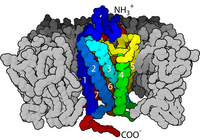
Photo from wikipedia
Eicosanoids are potent lipid mediators involved in central physiological processes such as hemostasis, renal function and parturition. When formed in excess, eicosanoids become critical players in a range of pathological… Click to show full abstract
Eicosanoids are potent lipid mediators involved in central physiological processes such as hemostasis, renal function and parturition. When formed in excess, eicosanoids become critical players in a range of pathological conditions, in particular pain, fever, arthritis, asthma, cardiovascular disease and cancer. Eicosanoids are generated via oxidative metabolism of arachidonic acid along the cyclooxygenase (COX) and lipoxygenase (LOX) pathways. Specific lipid species are formed downstream of COX and LOX by specialized synthases, some of which reside on the nuclear and endoplasmic reticulum, including mPGES-1, FLAP, LTC4 synthase, and MGST2. These integral membrane proteins are members of the family "membrane associated proteins in eicosanoid and glutathione metabolism" (MAPEG). Here we focus on this enzyme family, which encompasses six human members typically catalysing glutathione dependent transformations of lipophilic substrates. Enzymes of this family have evolved to combat the topographical challenge and unfavourable energetics of bringing together two chemically different substrates, from cytosol and lipid bilayer, for catalysis within a membrane environment. Thus, structural understanding of these enzymes are of utmost importance to unravel their molecular mechanisms, mode of substrate entry and product release, in order to facilitate novel drug design against severe human diseases.
Journal Title: Journal of molecular biology
Year Published: 2020
Link to full text (if available)
Share on Social Media: Sign Up to like & get
recommendations!